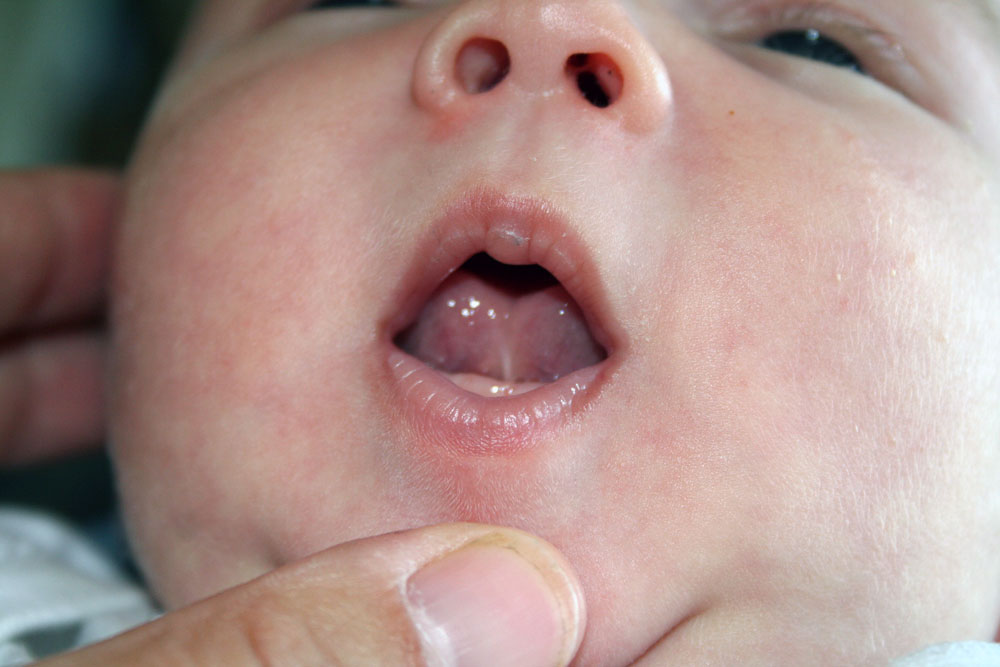If breastfeeding is painful for you and you have been looking on the internet to work out what is wrong you may have come across “tongue-tie” and be wondering if your baby has one. Although it is popular on social media to blame everything on your baby’s tongue function, most cases of breastfeeding pain can be solved by improving the way a baby is positioned at the breast. Working with an IBCLC lactation consultant and checking Causes of Sore Nipples and Why Does Breastfeeding Hurt? will help rule out the many other causes of breastfeeding problems that do not involve a tongue-tie.
This article
This article looks at what tongue-tie is, how it might affect breastfeeding, how to know if your baby has a tongue-tie, treatment options and where to find help.
What is tongue-tie?
Tongue-tie (ankyloglossia) is the term used to describe a tongue with restricted mobility; for example the tongue cannot poke out of the mouth past the lips or move freely. One of the factors affecting the tongue’s movement is the membrane under the tongue (known as the lingual frenulum). If this frenulum is particularly short or tight, it can appear to tie the tongue to the base of the mouth so it can’t move freely and is called a tongue-tie. The lingual frenulum is often described as a cord like membrane or like the sail on a boat under the tongue. Newer research describes the frenulum as being part of the floor of the mouth drawn up into a midline fold under tension when the tongue is raised.12
The tongue and breastfeeding
It makes sense that if the tongue can’t move freely this could affect breastfeeding negatively. But to what degree? Lactation consultant Diana West IBCLC describes a popular view of the tongue’s role during breastfeeding in the following excerpt:
Having a tongue that is tied to the base of the mouth can make it hard for a baby to breastfeed because there are several motions his tongue needs to make to remove milk effectively. It must extend comfortably past the lower lip so that it can grasp an adequate amount of breast for latching deeply. The sides of the tongue need to be able to cup the breast to stabilize it in his mouth. The tip of the tongue needs to be able to lift higher than halfway when the mouth is open, and the back of the tongue needs to lift and then drop to create the vacuum that pulls out milk.
However, new research suggests the tongue actually has quite limited movement during breastfeeding and moves with the lower jaw, apart from during swallowing.3 Australian author, doctor and lactation consultant Pamela Douglas explains:
The tongue does not take an active lead in infant sucking, but responds dynamically to intra-oral breast tissue volume: that is, the tongue’s shape, elevation and spread conform to the amount of breast tissue in the mouth.
The tongue does not need to actively lift midway to the palate, to lateralise, or to extend beyond the lower gum/inner edge of lower lip. It does not strip the breast or have peristaltic movements.
This perspective raises concerns about the rationale for some frenotomies if the range of tongue movement previously used to assess function was not accurate.

How can tongue-tie affect breastfeeding?
The following breastfeeding challenges are often associated with tongue-tie but other explanations are possible and should not be overlooked—see “Rule out other causes” below.
- Nipple pain, deep breast pain, misshapen nipples, nipple blisters, nipple vasospasm or very sore nipples for mother.
- A baby who has difficulty attaching to the breast (latching on), latching deeply enough, opening his mouth wide enough or staying latched on.
- A baby may have very short frequent feeds or fall asleep at the breast before the end of a feed or seem to feed all the time but doesn’t gain much weight.
- Sucking blisters on baby’s lips—because the lips are having to compensate for poor tongue function.
- Clicking sounds during breastfeeding—the sound of losing suction with the breast and/or difficulty coping with milk flow
- Reflux is sometimes said to be associated with a tongue-tie
Beyond breastfeeding
In later life restricted tongue movements could cause difficulty with licking the lips or an ice-cream, or keeping the teeth clean. Speech may be affected in a small number of children but one study group agreed that tongue-tie does not typically affect speech.4
Rule out other causes
Breastfeeding issues sometimes attributed to tongue-tie could be from other causes. Your breastfeeding specialist can help identify if there are any correctable issues that could be causing pain or difficulty breastfeeding such as:
- Positioning and attachment. A shallow latch or poor positioning can also affect how a baby breastfeeds and explain pain, sore nipples, blisters on a baby’s lips (or mother’s nipples), low milk supply, and clicking sounds.
- Anatomy. Babies can have difficulty with variations of a mother’s anatomy such as flat or inverted nipples, or large breasts or their own anatomy e.g. a small mouth compared to their mother’s nipple.
- Underweight baby. A hungry baby who is not gaining weight can have high tone, be very sleepy, fall asleep without feeding well or seem to feed all the time.
- Tension from the birth. Tension or compression from a baby’s birth is thought to influence tongue function through high muscle tone and with the idea that some types of restriction can be helped with physical therapy such as cranial work.56
- Reflux/allergy. Food allergy or intolerance can be associated with reflux, difficulty breastfeeding, high muscle tone, a baby seeming unable to latch and sore nipples due to a biting action at the breast including using the tongue as a piston against the nipple as a result of baby’s discomfort.7 In 2020 the Australian Dental Association concluded there was not enough evidence to link reflux to tongue-tie.8
Is my baby tongue tied?
Identifying a tongue-tie requires assessing tongue function in the context of breastfeeding, not just looking at the appearance of the tongue or ticking off a list of symptoms. A website or virtual breastfeeding forum can’t diagnose a tongue-tie, your baby needs a face-to-face consultation with a specialist. A good place to start is by seeing an IBCLC lactation consultant who will take a full breastfeeding history—and assess both breastfeeding and tongue function. Your lactation consultant may be able to help your baby breastfeed comfortably or find other explanations for any pain you may have. Where appropriate, your lactation consultant can arrange a referral to a tongue-tie practitioner or you might be able to self-refer depending on the referral system in your area. A tongue-tie provider might be a paediatric surgeon, midwife, or other health professional trained in dividing tongue-tie.
Assessing tongue function?
Just because there is a membrane to see, even if it is pulling on the tip of the tongue to create a heart shaped tip, it may not prevent your baby from breastfeeding or cause any nipple discomfort, it depends how much it restricts the tongue’s movement. Equally just because there is nothing to see under the tongue, doesn’t necessarily mean there isn’t an issue with the way baby is using their tongue. Your experienced lactation consultant will know how to assess your baby’s tongue function and their positioning and attachment at the breast.
Getting the right help
If your baby’s breastfeeding problems are associated with a tongue-tie you will need to find the right help. Tongue-tie practitioners can vary in how they approach tongue-tie treatment. In some areas tongue-tie is over diagnosed whereas in others the health professionals do not believe tongue-tie is a problem requiring treatment.
Posterior vs anterior
Tongue-ties are often described as anterior or posterior. An anterior tongue-tie describes the tongue that is tied to the floor of the mouth by a short membrane near or at the tip of the tongue. A posterior tongue-tie is used to describe a restrictive membrane at the back of the tongue which may not always be visible (submucosal). Both types are said to have potential to cause problems with breastfeeding if very tight, however research questions the term “posterior tongue-tie” as misleading and inaccurate.9 Pamela Douglas says that there is no anatomic or functional basis for the diagnosis of posterior tongue-tie and any studies that suggest treating posterior tongue-tie is beneficial are flawed or biased.10
Alison Hazelbaker, tongue-tie author takes the view:
enough tissue must be removed (without cutting into muscle) to restore optimal tongue mobility in some babies
Where can I find a practitioner?
- Your IBCLC will usually be able to recommend practitioners in your area who are familiar with the diagnosis and treatment of tongue-tie. See Why Hire an IBCLC? for links to IBCLC directories in UK and internationally.
- The Association of Tongue-Tie Practitioners maintains a list of tongue-tie practitioners in the United Kingdom.
What is the treatment for tongue-tie?
A restrictive tongue-tie can be treated by a frenotomy (or frenulotomy), this is a medical procedure that involves cutting (dividing) the membrane under the tongue by scissors or laser. One review states there is not enough evidence to recommend one technique over another (Messner et al) while another suggests the age of the baby is important with scissors recommended for babies (ADA, 2020). A comprehensive approach for a restrictive tongue-tie might include a combination of improved positioning at breast, bodywork or tongue exercises if appropriate, and/or frenotomy. The most common method of dividing frenulums in the United Kingdom (UK) is to use sharp, blunt-ended surgical scissors. A tongue-tie practitioner in the UK describes the procedure:
The baby is wrapped securely in a towel or blanket so they cannot wriggle or put their hands to their mouth. The head is then held still by a parent, nurse, or other helper. The practitioner performing the procedure lifts the tongue using the finger or fingers of one hand. (Some practitioners prefer to use a Brodie Director, a small metal spade shaped instrument with a central slit to isolate the frenulum and lift the tongue). With the scissors in the other hand the practitioner slides the blades under the tongue, so they are on either side of the frenulum and snips.
Some babies sleep through the procedure or go straight to the breast for soothing. However some babies can be unsettled for a few days afterwards with difficulty feeding and with increased crying (Oakley, 2024). Complications from the procedure can be mild or occasionally more serious (ADA, 2020).
Contraindications
Frenotomy is not recommended for all babies. Contraindications include having a neurological disorder, hypotonia (low muscle tone), receding chin (retrognathia), small lower jaw (micrognathia) or a bleeding disorder (Messner et al, 2020).

Wound care
Occasionally a tongue-tie can reform after a frenotomy. Many practitioners find the natural tongue movements of frequent breastfeeding help to prevent the frenulum reforming exactly as before and, where needed, gentle tongue exercises can help strengthen the tongue.11 Some practitioners advocate that parents actively stretch or massage the wound daily to prevent the tie returning.12 However the Australian Dental Association’s 2020 consensus statement does not recommend stretching of surgical wounds (“active wound management”) saying there is no scientific evidence to support it and that it prolongs healing and increases the risk of infection and scarring (ADA, 2020). In addition, massaging the wound can cause a baby considerable pain and distress or breast refusal.13
What about lip-ties?
The membrane that connects the inside of the upper lip to the gum is known as the labial frenulum. The idea that latching problems could be caused by this membrane being too short or tight (a lip-tie) seems to be a relatively new idea. During breastfeeding the upper lip need only be in a neutral or slightly everted position at the breast not flanged out like the lower lip1415 and there isn’t any published research supporting the idea that lip-ties are associated with feeding issues.161718 In many cases “lip-ties” are confused with normal anatomy.1920 and the presence of an upper lip frenulum tight enough to disrupt breastfeeding is unusual. Tension in the upper lip can be associated with a shallow latch, unstable positioning at the breast, high muscle tone or a tongue-tie, and any of these could lead to a misdiagnosis of lip-tie. See Lip-Tie and Breastfeeding for more information.
If breastfeeding still hurts
A frenotomy does not always improve breastfeeding comfort and may not be a magic wand for a baby not gaining weight. A tight frenulum may not have been the cause of the problem after all. In most cases breastfeeding problems are associated with positioning (Messner et al. 2020). If you are still finding breastfeeding painful see Why Does Breastfeeding Hurt? and stay in contact with your IBCLC lactation consultant for follow ups in case there is another problem yet to be solved.
Summary
A tongue-tie describes the situation where the membrane that joins the underside of the tongue with the floor of the mouth is said to be particularly short or tight and restricts normal tongue function. If a baby’s tongue can’t move normally, breastfeeding can be be painful for his mother, and it will usually be difficult for the baby to get enough breast milk which may lead to slow weight gain. Poor tongue function can also be frequently seen with a shallow latch, poor positioning or physical issues such as pain or tension from a difficult birth. If breastfeeding is not going well, an IBCLC lactation consultant will take a full history and assessment of breastfeeding to pinpoint the most likely causes of your difficulties and to find the right care plan for you and your baby. If a frenotomy (surgical division of the tongue-tie) is recommended, it is important to find an experienced and knowledgable tongue-tie practitioner. More research is needed regarding the best tool to use (scissors or laser), best wound care, the role of bodywork or the value of lip-tie frenotomy.

